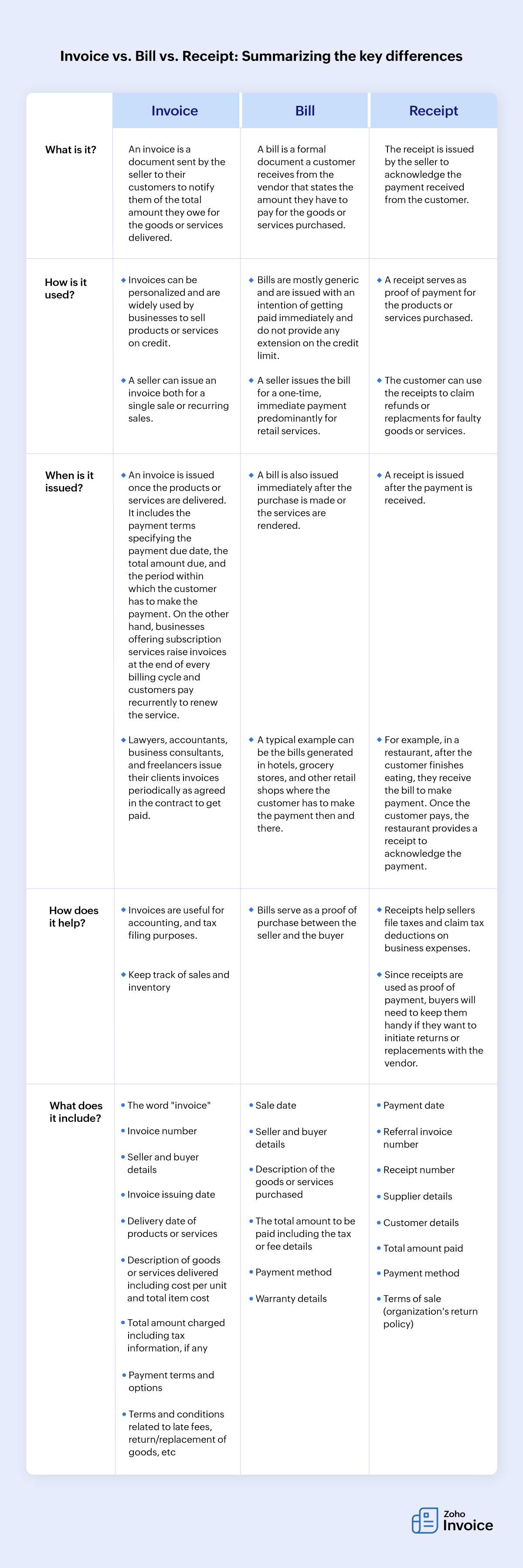
You might have come across the terms invoice, bill, and receipt in your daily life. Although these terms are often used interchangeably, barring some similarities, they are fundamentally different from each other. This guide will walk you through what each of them does and how they are different from each other in detail.
Before continuing, you can learn all about invoices here.
A bill is a document issued by the vendor that specifies the amount the buyer owes for the goods or services purchased from them. In a B2C setting, say, a retail store or a restaurant, the buyer is expected to pay immediately after receiving the bill. Whereas during B2B transactions, bills payable show the amount customers owe for the goods and services sold on credit and is expected to be paid by a certain date. It can include service invoices, phone bills, and utility bills. Like invoices, bills serve as legal evidence of the transaction.
A bill and an invoice refer to the same document which conveys the amount owed as part of the business transaction. The difference is how it is perceived, depending on whether you are a seller or a buyer.
When a seller sends an invoice requesting payment, the buyer will receive it as a bill. For instance, on delivering their work as per the agreement, a freelance designer would send an invoice to their customer. For the customer, the document received would function as a bill. To sum it up, sending an invoice is to request payment and receiving a bill is to pay for the purchase.
Apart from this, the timeline by which the client is expected to pay plays a differentiating factor. Few businesses and vendors, especially in the B2B setting, offer products or services on credit, which means the client can purchase and pay the vendor later as per the agreed-upon payment terms. In such cases, after delivering the goods or services, the supplier sends an invoice. If the invoice includes payment terms, such as Net 30 (which indicates that the client is supposed to make payment within 30 days upon receiving the invoice), the customer is expected to pay within the timeframe stated. So when it comes to invoices, there is an option to pay later.
However, a bill is issued immediately following the product or service delivery, and the seller expects their clients to make payment then and there. A typical example can be the bill issued after your stay at a hotel which is to be paid before you checkout.
So the main difference is that while an invoice is sent (by the seller), a bill is received (by the customer).
A receipt is an acknowledgement or proof of payment. It contains the seller's details and the buyer's, including the items bought, the date of payment, the amount paid, and other relevant information.
Invoices and receipts are similar—they serve as a record of sales and contain mostly the same information. The difference lies in when they are issued and how they are used for accounting purposes. While an invoice is raised to get payment from the customer, a receipt is issued after receiving the payment from the customer.
Typically, a receipt is issued only after the customer pays in full. Other than the obligation to fulfill refunds or replacement claims, the sale is considered closed. A receipt serves as a record of a completed sale, which goes into the books as income.
On the other hand, the sellers can issue invoices to their customers who have credit accounts, enabling them to get the goods or services beforehand and pay later. Sellers can even split the total amount into several invoices and get paid in installments.
Invoices are recorded differently in the accounting system. Rather than registering the sale as income, the invoices are marked for further processing and treated as accounts receivable. Only when the full payment is received for the goods or services provided, will the sale be considered complete and recorded as income in the books.

To summarize, if you are a vendor, once the items are delivered to your customer, you would raise an invoice to collect the amount owed. Once the customer pays you, generate a receipt acknowledging the payment. On the flip side, if you are a customer, the invoice you receive from the supplier is your bill, and once you pay your bill, you will get a receipt.